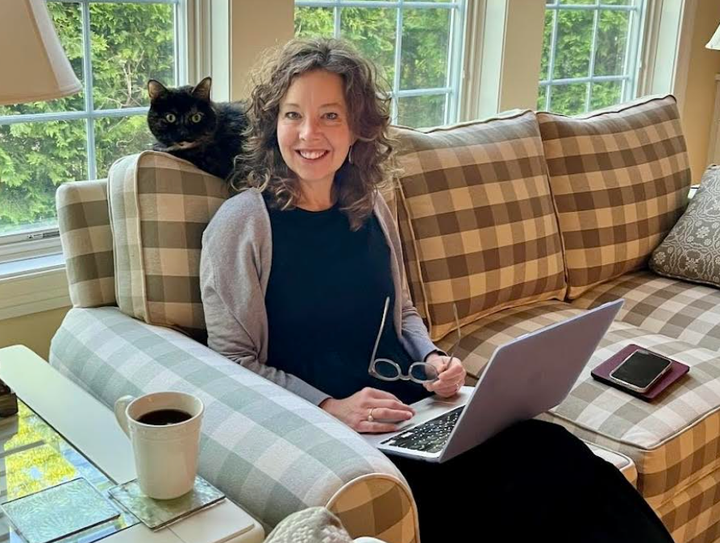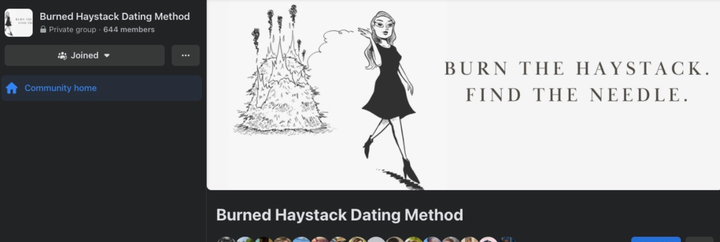
When I first got on the dating apps two years ago, at age 50, I was horrified.
Night after night I grew more demoralised, flipping through my “matches” of all the cliched nonsense I hadn’t really believed was real prior to experiencing it myself: fish pics and leering bathroom mirror selfies, and married men who wanted to “ethically explore.”
Was this really all there was? I wanted an actual partner, not just to be someone’s “partner in crime” from the backseat of his Harley so we could “keep it casual and see what happens.”
I also hadn’t realised how much my age would work against me. I thought I’d be okay because my married girlfriends told me I looked good for my age, but what we didn’t understand is that a lot of men my age don’t even want to date women my age. They want to date 30-year-olds.
Still, there had to be a few decent, desirable, monogamous men out there who wanted the same things I did and who wanted them with a woman in their own age group. I was convinced I was missing something about how to make these apps work in my favour. None of the advice I read online made any difference in helping me to find my needle in the haystack.
Then late one night, bleary-eyed from scrolling and swiping, I googled “How do you find a needle in a haystack?” I was really just fooling around, but when I saw the answer, I got chills. The answer — the way you find an actual needle in an actual haystack — is to burn the haystack to the ground. What you’ll be left with is the needle, because metal doesn’t burn.
I knew this had to be the key. All this picking through pieces of hay to find one needle was too tedious and it took too damn long. I understood that younger women used Tinder almost like a sport or as a kind of video game, that they weren’t always using it to find “the one.” But at my age I didn’t feel like I had that kind of time. I wanted to burn the whole haystack down and find my needle.
I went back to the apps and started applying a few simple rules (more on that below). It changed everything. I got so strict about what and who I was willing to engage with that nearly 100% of my effort was now spent only on men whose values and goals aligned with mine.
Five days later, I found my needle. We both shut down our dating app accounts after the first date (probably not advisable, but what can I say; we did). He was everything I wanted: kind, funny, stable, family-oriented, professionally successful, and inherently monogamous like me. We dated for two years and for reasons too complicated to get into here, it ultimately didn’t work out. He’s still one of my best friends, and I wouldn’t trade the experience for anything.
But I still wanted a partner. When it was time for me to try again, I decided I was going to formalise my haystack-burning method and share it with others. This was going to be my feminist revolution — my own (decidedly less-lofty) version of Gandhi’s “being the change I wished to see in the world.”
It also occurred to me that, even though people are finally realising that older women are on the rise everywhere from corporate America to Hollywood, nobody had recruited us yet to work on the disaster that’s the dating apps.

Gen X women were made for this disaster. We’re a generation characterised by resourcefulness, self-sufficiency and creativity. We’re tech-savvy but not tech-dependent, which means that we’re perfectly capable of navigating the apps, but generationally less likely to scroll ourselves into spirals of depression. We bring a stick-to-it-ness possessed only by those who spent our latchkey years figuring out how to do things without the benefit of YouTube. We’ve also, at our age, honed incredibly sharp bullshit detectors and are in possession of a hormonal balance that renders us unwilling to suffer fools yet prepared to take no prisoners. All these attributes align perfectly with the process of burning the haystacks in dating apps.
I started a Facebook group that I called “Burned Haystack Dating Method” with a small group of friends and colleagues that’s now grown to over 850 women across the globe, the vast majority of us over age 40. We began with my burned haystack method and how I’d used it previously, and we collectively hammered it into 10 clear “rules” for using the dating apps to burn the haystack.
For example, we interact only with individual messages that are well-written, reference our profiles, and do something to extend the conversation –– no more entertaining “hey gorgeous” messages or men whose profiles contain only their cellphone numbers because they’re not actually paying to use the app.
We refuse to be pen pals, and we refuse to fight with men or to waste any of our time and energy putting them in their place, even if they deserve it (women still take a lot of abuse and aggression on dating apps). Instead, we just block them.
If a conversation is decent but not moving toward meeting in real life within a week or two, we block without further interaction. “Block to burn” has become a mantra in the Burned Haystack group because blocking is the only way to prevent the apps from recycling matches. If you “block” rather than just swipe left, you’re assured of not seeing that guy again, which means the app has no choice but to show you new matches that might be much better.
Employing these tricks and others is paying off. We’re suddenly meeting men who are respectful and relationship-minded, and we’re actually going out on good dates. There’s no accounting for chemistry, of course — I don’t think any method can ensure that. But the rules do ensure that even when there’s no soulmate connection, we’re meeting really nice men and actually enjoying it.
And if something’s not working — if someone is following all the rules and not experiencing success — then we crowdsource to troubleshoot. Is there confusion about how algorithms work? We have data scientists in this group. Do you feel like online dating is tanking your mental health? Let’s consult with the psychologists. Are there questions about legal or ethical matters related to virtual dating? We have several attorneys among us.
I’m not a “dating coach” and I don’t take on individual clients. The whole “Burned Haystack” project is grassroots and non-monetised; nobody is profiting financially from this work — not me, not the amazingly accomplished professional women in the group who so generously share their individual expertise, and not the members of a smaller research cohort I convened that meets once per month via Zoom to develop and test new strategies that we then share with the larger group.
!["The 'Burned Haystack Dating Method' project includes a designated smaller research cohort," the author writes. "We meet via zoom once per month to share experiences, tweak approaches, and generally support one another. The members (10 total, only three, including myself [top right] are pictured here) stretch from coast to coast in America, and one member lives in Australia!"](https://img.huffingtonpost.com/asset/64d9346b22000058000bb3da.png?ops=scalefit_720_noupscale)
I’ve never had any doubts about the power of women individually or collectively — especially women who’ve stacked up lifetimes of experiences and hardships and losses and victories — but this group shines like nothing I’ve ever seen in terms of highlighting what a committed, organised sisterhood can accomplish.
In addition to finding good dates, we’re also building a community of friendship, creativity, and mutual support. And I’d be remiss if I didn’t mention humour, which is essential. After you’ve spent hours swiping through pictures of 55-year-old men who “want kids someday,” it really does help to have kindred spirits to laugh with.
On a more personal note, it’s not an exaggeration to say that this group and this project have changed my life and shifted the trajectory of my career. I have a doctorate in rhetoric and am a full-time professor who works with young people, many of whom have shared with me their own horror stories of experiences on the dating apps. At the beginning, my only goal was to combine my personal experience, my concern for my students, and my academic expertise to more effectively game the dating apps — it was purely logistical.
I started with middle-aged women who date cis-hetero men because that was my own lived experience and I wanted to kick off the project on a solid ethos of authenticity. But one of our first big Burned Haystack success stories involved a relationship between two women (who are now together and exclusive!). What we’re realising collectively is that this method could help anyone who’s searching for a partner, regardless of age, gender, or orientation.
As the group continues to grow, I find myself harbouring aspirations of it turning into an actual movement. I find myself having daydreams about what could happen if a critical mass of people start intentionally burning the haystack in the dating apps. In a way, I think the apps got to us before we were emotionally or psychologically prepared to handle them, and the result is that the majority of the entire dating population is now mired in a system that seems to serve almost no one effectively.
Following the Burned Haystack Method requires us to slow down, to be mindful, to be honest, and to be kind — both to the people we meet and to ourselves. It also empowers us to be strong and self-protective in ways that are generative and healing. Doing all of this in a group, of course, intensifies all of these positive effects.
To be fair, the dating app experience overall is still kind of a mess, but middle-aged women are the perfect group to clean it up, and we’re cleaning it up for everyone. At this point in our lives, we’ve cleaned up the messes of spilled Cheerios and teenagers’ bedrooms and alcoholic exes and our elderly parents’ iPhones. Surely we can take on the dating apps and do some good.
For more information on the Burned Haystack Dating Method, visit the group on Facebook here or on Instagram @word_case_scenario.
Jennie Young is a writer and professor at University of Wisconsin, Green Bay. Her writing can be seen in McSweeney’s, Ms. Mag, The Independent, HuffPost, Education Week, Inside Higher Ed, Weekly Humorist, and others; she moderates the Burned Haystack Dating Method group on Facebook and posts additional content on Instagram @word_case_scenario.